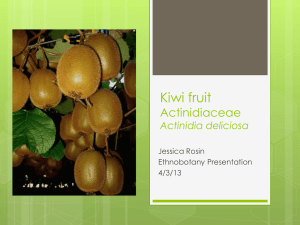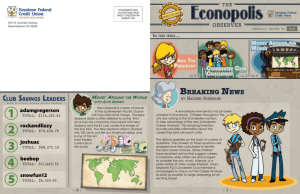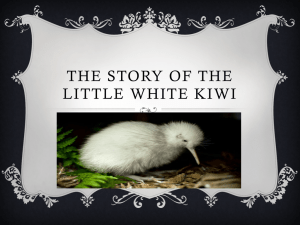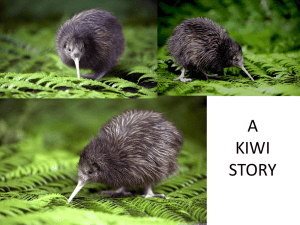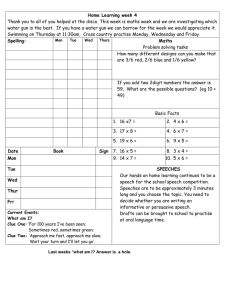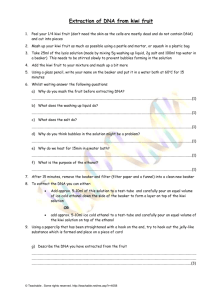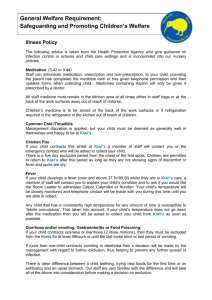Kiwi population recovery through community
advertisement
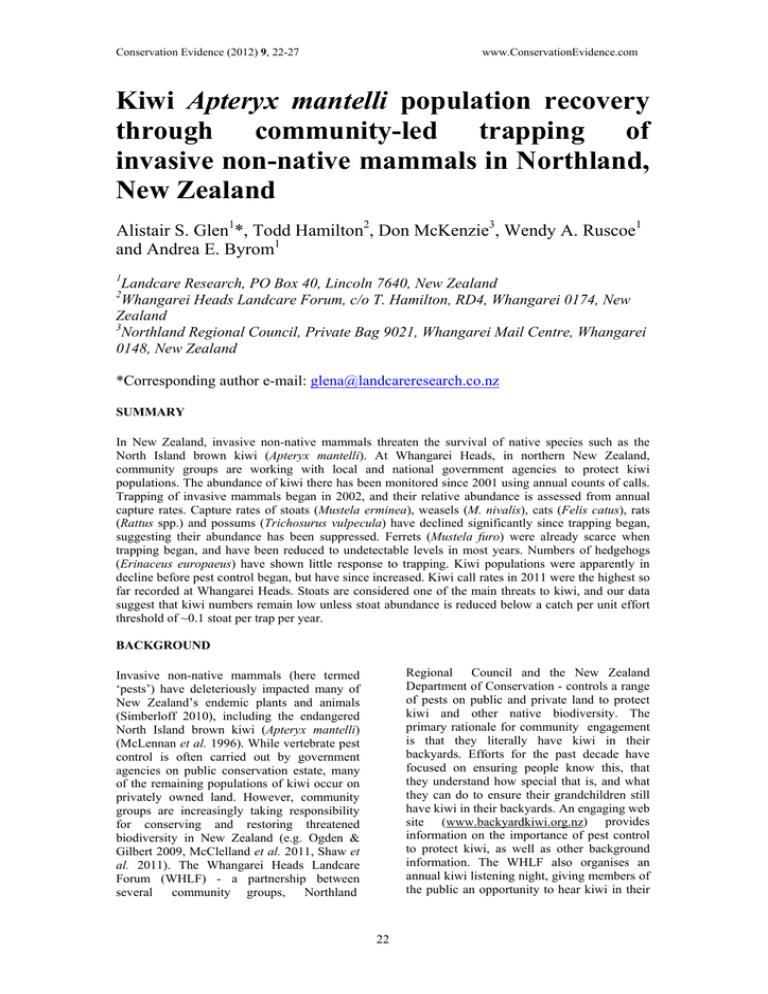
Conservation Evidence (2012) 9, 22-27 www.ConservationEvidence.com Kiwi Apteryx mantelli population recovery through community-led trapping of invasive non-native mammals in Northland, New Zealand Alistair S. Glen1*, Todd Hamilton2, Don McKenzie3, Wendy A. Ruscoe1 and Andrea E. Byrom1 1 Landcare Research, PO Box 40, Lincoln 7640, New Zealand Whangarei Heads Landcare Forum, c/o T. Hamilton, RD4, Whangarei 0174, New Zealand 3 Northland Regional Council, Private Bag 9021, Whangarei Mail Centre, Whangarei 0148, New Zealand 2 *Corresponding author e-mail: glena@landcareresearch.co.nz SUMMARY In New Zealand, invasive non-native mammals threaten the survival of native species such as the North Island brown kiwi (Apteryx mantelli). At Whangarei Heads, in northern New Zealand, community groups are working with local and national government agencies to protect kiwi populations. The abundance of kiwi there has been monitored since 2001 using annual counts of calls. Trapping of invasive mammals began in 2002, and their relative abundance is assessed from annual capture rates. Capture rates of stoats (Mustela erminea), weasels (M. nivalis), cats (Felis catus), rats (Rattus spp.) and possums (Trichosurus vulpecula) have declined significantly since trapping began, suggesting their abundance has been suppressed. Ferrets (Mustela furo) were already scarce when trapping began, and have been reduced to undetectable levels in most years. Numbers of hedgehogs (Erinaceus europaeus) have shown little response to trapping. Kiwi populations were apparently in decline before pest control began, but have since increased. Kiwi call rates in 2011 were the highest so far recorded at Whangarei Heads. Stoats are considered one of the main threats to kiwi, and our data suggest that kiwi numbers remain low unless stoat abundance is reduced below a catch per unit effort threshold of ~0.1 stoat per trap per year. BACKGROUND Regional Council and the New Zealand Department of Conservation - controls a range of pests on public and private land to protect kiwi and other native biodiversity. The primary rationale for community engagement is that they literally have kiwi in their backyards. Efforts for the past decade have focused on ensuring people know this, that they understand how special that is, and what they can do to ensure their grandchildren still have kiwi in their backyards. An engaging web site (www.backyardkiwi.org.nz) provides information on the importance of pest control to protect kiwi, as well as other background information. The WHLF also organises an annual kiwi listening night, giving members of the public an opportunity to hear kiwi in their Invasive non-native mammals (here termed ‘pests’) have deleteriously impacted many of New Zealand’s endemic plants and animals (Simberloff 2010), including the endangered North Island brown kiwi (Apteryx mantelli) (McLennan et al. 1996). While vertebrate pest control is often carried out by government agencies on public conservation estate, many of the remaining populations of kiwi occur on privately owned land. However, community groups are increasingly taking responsibility for conserving and restoring threatened biodiversity in New Zealand (e.g. Ogden & Gilbert 2009, McClelland et al. 2011, Shaw et al. 2011). The Whangarei Heads Landcare Forum (WHLF) - a partnership between several community groups, Northland 22 Conservation Evidence (2012) 9, 22-27 www.ConservationEvidence.com local area. Through such measures, volunteers are recruited from the local community for the annual kiwi call count. Pest trapping and public liaison are conducted by the Project Manager (T. Hamilton) with support from funding organisations and public donations. In addition to pest control, the WHLF monitors the abundance of pests and kiwi. We used these data to investigate whether (1) trapping has reduced the abundance of targeted pests at Whangarei Heads and (2) kiwi populations have responded to pest control. (a) 0.35 Ferret Stoat Catch per unit effort 0.3 Weasel 0.25 0.2 0.15 0.1 0.05 0 2003 ACTION 2004 2005 2006 2007 2008 Year ending 2009 2010 2011 (b) 8 Whangarei Heads is a peninsula around 150 km NNW of Auckland, North Island, New Zealand (35° 48’ S, 174° 31’ E). The area of ~6000 ha has various land uses including livestock grazing, small rural holdings and coastal settlements. At the extremity of the peninsula is a publicly-owned conservation reserve. Despite habitat clearance and residential development, Whangarei Heads retains significant native biodiversity, including indigenous forest remnants and populations of endangered North Island brown kiwi, but this is threatened by invasive plants and animals. Of particular concern for kiwi conservation are invasive non-native mammalian predators. 7 Catch per unit effort 6 5 Hedgehog Rat Cat Possum 4 3 2 1 0 2003 2004 2005 2006 2007 2008 2009 2010 2011 Year ending Figure 1. Annual capture rates of invasive mammals at Whangarei Heads, Northland, New Zealand: (a) ferrets (Mustela furo), stoats (M. erminea) and weasels (M. nivalis); (b) hedgehogs (Erinaceus europaeus), rats (Rattus spp.), cats (Felis catus) and possums (Trichosurus vulpecula) Pest populations: Trapping of invasive mammals began in October 2002. Stoats (Mustela erminea), weasels (M. nivalis), ferrets (M. furo), rats (Rattus rattus and R. norvegicus) and hedgehogs (Erinaceus europaeus) are trapped in kill-traps, comprising Mark 6 Fenn traps (FHT Works, Redditch, England), DOC 200 and DOC 250 traps (Department of Conservation, Wellington, NZ). These are permanently set in plastic tunnels or wooden boxes to exclude non-target species, baited with salted rabbit (Oryctolagus cuniculus) or possum (Trichosurus vulpecula) meat, and checked once each month. Feral cats (Felis catus) and possums are captured using SA Conibear-type kill traps (Steve Allan, Northland, NZ) baited with a variety of lures such as peanut butter, cat biscuits and minced rabbit. Occasionally where stray or feral cats are reported frequenting a particular area, small numbers of cage traps are deployed. These are checked daily and captured animals are checked to ensure that they are not owned (no collar or microchip) before being humanely dispatched. The number of traps used increased gradually from about 200 in 2002 to 300 in 2011. We therefore use annual catch per unit effort (CPUE) as an index of pest abundance. This was calculated as the number of captures divided by the number of traps deployed in any given year. Although some possums were trapped in the first two years, their numbers were not recorded consistently until 2005 (Hamilton 2005). We therefore used 2005 as the start year for our analysis of possum captures. To determine whether differences in capture rates between the first and last year of trapping were statistically significant, we calculated the capture rate ratio and associated 95% confidence intervals (Kirkwood & Sterne 1988). A rate ratio > 1 indicates an increase in CPUE, while < 1 indicates a decrease. Where the 95% confidence interval does not overlap 1, we infer a statistically significant difference. Kiwi populations: Monitoring of kiwi populations has taken place annually since 2001, the year before pest control began. 23 Conservation Evidence (2012) 9, 22-27 www.ConservationEvidence.com 2 Capture rate ratio (with 95% CI) 1.8 1.6 1.4 1.2 1 0.8 0.6 0.4 0.2 0 Stoats Weasels Hedgehogs Rats Cats Possums Figure 2. Rate ratios < 1 show that capture rates of most pest species at Whangarei Heads have fallen since trapping began. Where the 95% confidence interval (CI) does not overlap 1, the reduction in capture rate is statistically significant. Experienced volunteers record the number of kiwi calls heard per hour at 12 listening stations across Whangarei Heads. Although more listening stations have been established over time, for consistency we have restricted our comparisons to the original 12 stations. Call rates are recorded over 8 hours (four 2hour periods commencing at dusk on separate nights) by one or two observers at each listening station. Call counts are conducted in May-June during the kiwi breeding season, coinciding with the dark phase of the moon. The number of calls recorded per hour is used as an index of kiwi abundance (BNZ Save the Kiwi Trust 2012). We used abundance indices from consecutive years to estimate the population’s exponential rate of change over each 12-month period, using the formula r = ln(nt) – ln(nt-1), where r = exponential rate of change, nt = abundance at time t, and nt-1 = abundance in the preceding year. Positive values of r indicate population growth, negative values indicate decline, and a value of zero denotes a stable population (Caughley 1977). Since stoats are considered a severe threat to kiwi populations (McLennan et al. 2004), we plotted the relationship between stoat CPUE and kiwi call rates, which we interpret visually. trapping began. No ferrets had been recorded since 2004/05 until a single individual was trapped in 2010/11 (Fig. 1a). Capture rates of possums, rats and cats have decreased since trapping began, while capture rates of hedgehogs have remained relatively constant (Fig. 1b). Capture rate ratios less than 1 confirm that reductions in CPUE between the first and last year of trapping were statistically significant for all pest species except ferrets (for which there were too few captures for analysis) and hedgehogs (Fig. 2). The effectiveness of the trapping programme is further illustrated by the fact that recent stoat captures have occurred mainly on the landward side of the peninsula (T. Hamilton, unpublished data). This is likely due to reinvasion from adjacent areas, rather than the continued presence of large numbers of stoats on the peninsula itself. This is important because, of all the invasive mammals being controlled at Whangarei Heads, stoats are likely to present the greatest threat to kiwi populations (McLennan et al. 2004). Kiwi populations: Mean indices of kiwi abundance declined from 3.6 calls per hour in 2001 to a low of 2.7 calls per hour in 2007 (Fig. 3). However, call rates have since recovered, reaching a peak of 5.6 calls per hour in 2011. The population’s estimated exponential rate of change (Fig. 4) has been positive (indicating population growth) or CONSEQUENCES Pest populations: Capture rates of stoats and weasels declined rapidly following the first year of trapping and have remained substantially lower than starting levels (Fig. 1a). Ferrets were already scarce before 24 Conservation Evidence (2012) 9, 22-27 www.ConservationEvidence.com 8 Kiwi calls per hour 7 Pest control 6 5 4 3 2 1 2011 2010 2009 2008 2007 2006 2005 2004 2003 2002 2001 0 Figure 3. Mean kiwi abundance (with 95% confidence intervals) as indexed by hourly call rates at 12 listening stations on Whangarei Heads. Exponential rate of change (r) 0.4 0.3 0.2 0.1 0 ‐0.1 ‐0.2 ‐0.3 2011 2010 2009 2008 2007 2006 2005 2004 2003 2002 ‐0.4 Figure 4. Annual exponential rate of change (r) of the kiwi population at Whangarei Heads. The population was in decline (r < 0) during the first year of monitoring, but has since stabilised and begun to increase (r > 0). 6 Kiwi calls per hr 5 4 3 2 1 0 0.0 0.1 0.2 0.3 Stoat catch per unit effort 0.4 Figure 5. When stoats at Whangarei Heads are relatively abundant, kiwi call rates are consistently around 3 per hour. At lower stoat densities (catch per unit effort < ~0.1 stoat per trap per yr), kiwi call rates range from 3.8 to 5.6 per hour. 25 Conservation Evidence (2012) 9, 22-27 www.ConservationEvidence.com close to zero (indicating a stable population) for the four years since 2008. encouraging dog owners to keep their animals restrained to prevent predation on kiwi. Unlike smaller predators such as stoats, dogs kill both adult and juvenile kiwi, posing an even greater threat to kiwi populations. With continued control of invasive mammals, and effective restraint of dogs, there is potential for kiwi populations to grow considerably. For example, elsewhere in Northland where stoats and other pests are controlled to low levels, even higher kiwi call rates have been recorded (Blunden 2009). The success of these operations illustrates the importance of community-led conservation in New Zealand. Such initiatives achieve important conservation benefits on privately owned land outside the jurisdiction of government conservation agencies. As well as the benefits to kiwi reported here, pest control is likely to benefit other native species and ecological processes. Organisations such as the WHLF also play an important role in raising community awareness and engaging the public in active conservation. Community-led pest control is therefore an important addition to similar measures conducted by government agencies on public land. Predator - prey relationships: Visual interpretation of our data suggests a strong negative relationship between the abundances of kiwi and stoats (Fig. 5). The relationship is not linear, but suggests that kiwi numbers remain low unless stoat abundance is reduced below a certain threshold (CPUE < ~0.1 stoat per trap per year). Similarly, fledging success of endangered kokako (Callaeas cinerea) increased dramatically when abundances of invasive possums and rats were reduced below critical thresholds (Innes et al. 1999). Conclusions: Kiwi populations at Whangarei Heads were apparently in decline before pest control commenced in 2002, but have increased substantially in recent years. Some caution is required in interpreting our results as only one year’s data are available before pest control began. In addition, without data from a non-treatment site for comparison, we cannot say with certainty that the observed changes were caused by trapping. However, the relationship between stoat and kiwi abundance is consistent with expectations that stoat control aids kiwi recovery (McLennan et al. 2004). At relatively high stoat abundances, kiwi call rates are consistently about 3 per hour. When stoat abundance is low, kiwi call rates are more variable, but can approach 6 per hour. This pattern suggests that stoat abundance must be below a critical threshold in order for kiwi populations to recover. Additional years of trapping and monitoring are required to confirm this pattern, but the results from the first decade suggest that community-led pest control has reversed the trend of the kiwi population at Whangarei Heads from one of decline to one of strong growth. Because kiwi do not commence calling until they reach maturity, there is a lag of approximately 2 years before increased survival of kiwi chicks leads to increases in call rates. This may help to explain why call rates did not increase for some years after trapping began, and also gives cause for optimism that further increases in call rates can be expected as recently fledged chicks reach maturity. ACKNOWLEDGEMENTS We thank Northland Regional Council, Biofunds and the BNZ Save the Kiwi Trust for their generous support of the Whangarei Heads Landcare Forum. Sincere thanks also to the dedicated volunteers who conduct annual kiwi call counts. Landcare Research staff were supported by a grant from the New Zealand Ministry of Research, Science and Technology (MSI contract C09X0909) and MSI core funding through the Weeds, Pests and Diseases Portfolio. We thank G. Blunden of the New Zealand Kiwi Foundation for data and discussions on kiwi populations elsewhere in Northland, G. Forrester for statistical advice, and D. Morgan and P. Cowan for helpful comments on an earlier draft. REFERENCES Blunden G. (2009) Pest Management Report for Mataka Station Residents' Association, January - June 2009. New Zealand Kiwi Foundation, Kerikeri, NZ. Pest control and monitoring at Whangarei Heads are continuing. The success of the project relies on the ability of the WHLF to continue to secure funding for a professional trapper, as well as engagement, training and commitment of local volunteers. In addition, the WHLF runs a public outreach campaign BNZ Save the Kiwi Trust (2012) Call count monitoring. Accessed 29 March, 2012. http://www.savethekiwi.org.nz/resources-to- 26 Conservation Evidence (2012) 9, 22-27 www.ConservationEvidence.com save-kiwi/call-count-monitoring/call-countmonitoring.html. McLennan J. A., Dew L., Miles J., Gillingham N. & Waiwai R. (2004) Size matters: predation risk and juvenile growth in North Island brown kiwi (Apteryx mantelli). New Zealand Journal of Ecology, 28, 241250. Caughley G. (1977) Analysis of Vertebrate Populations. Blackburn Press, Caldwell, New Jersey, USA. Hamilton T. (2005). Whangarei Heads Landcare Forum Predator Trapping Report December 2005. Unpublished report for the Whangarei Heads Landcare Forum. McLennan J. A., Potter M. A., Robertson H. A., Wake G. C., Colbourne R., Dew L., Joyce L., McCann A. J., Miles J. & Miller P. J. (1996) Role of predation in the decline of kiwi, Apteryx spp., in New Zealand. New Zealand Journal of Ecology, 20, 27-35. Innes J., Hay R., Flux I., Bradfield P., Speed H. & Jansen P. (1999) Successful recovery of North Island kokako Callaeas cinerea wilsoni populations, by adaptive management. Biological Conservation, 87, 201-214. Ogden J. & Gilbert J. (2009) Prospects for the eradication of rats from a large inhabited island: community based ecosystem studies on Great Barrier Island, New Zealand. Biological Invasions, 11, 1705-1717. Kirkwood B. R. & Sterne J. A. C. (1988) Essential Medical Statistics. 1st edn. Blackwell Science, Malden, MA, USA. Shaw V., Whitehead J. D. & Shaw C. T. (2011) Creating an island sanctuary: a case study of a community-led conservation initiative. In: Island Invasives: Eradication and Management. Proceedings of the International Conference on Island Invasives. (Veitch C. R., Clout M. N. & Towns D. R. eds.) IUCN, Gland, Switzerland and Auckland, NZ. pp 496-499. McClelland P. J., Coote R., Trow M., Hutchins P., Nevins H. M., Adams J., Newman J. & Moller H. (2011) The Rakiura Titi Islands Restoration Project: community action to eradicate Rattus rattus and Rattus exulans for ecological restoration and cultural wellbeing. In: Island Invasives: Eradication and Management. Proceedings of the International Conference on Island Invasives. (Veitch C. R., Clout M. N. & Towns D. R. eds.) IUCN, Gland, Switzerland and Auckland, NZ. pp 451-454. Simberloff D. (2010) Invasive species in New Zealand. In: Conservation Biology for All. (eds Sodhi N. S. & Ehrlich P. R.) Oxford University Press, UK. pp 132-133. Conservation Evidence is an open-access online journal devoted to publishing the evidence on the effectiveness of management interventions. The pdf is free to circulate or add to other websites. The other papers from Conservation Evidence are available from the website www.ConservationEvidence.com 27
